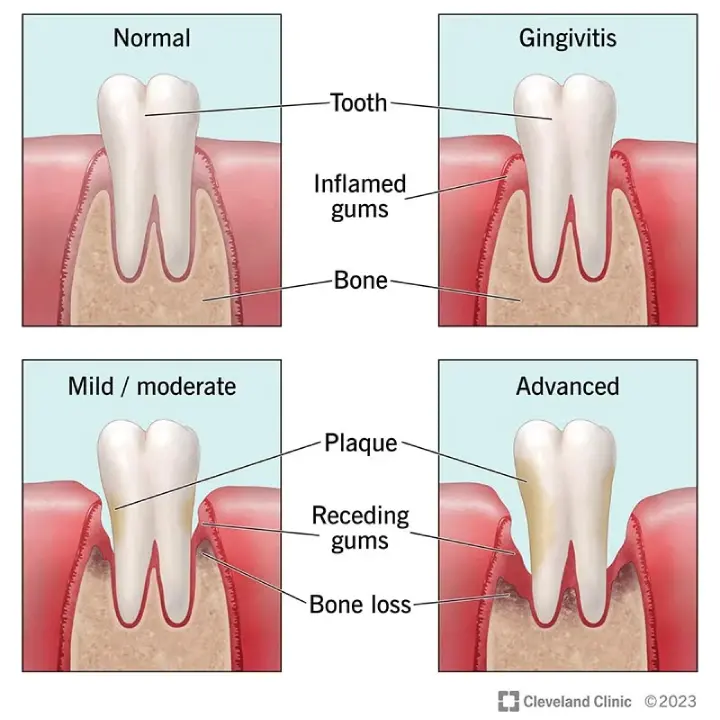
Periodontal disease aka gum disease
Specialized dental care for periodontal disease
If you’re experiencing any periodontal disease symptoms, Dental Corner is here for you. Book an appointment with your local periodontist today.
Periodontal disease (periodontitis) treatment options
Treat for early-stage gum disease (gingivitis) treatment options
Your Dental Corner dentist will work with you to determine the best care plan for you and your smile. Discover possible periodontal disease treatment options below.
Dental cleaning and improved oral hygiene. Gingivitis is the earliest stage of gum disease. It’s relatively easy to treat and can usually be controlled with a cleaning from your Dental Corner care team.
Treatment for periodontitis
Your Dental Corner dentist will work with you to determine the best care plan for you and your smile. Discover possible periodontal disease treatment options below.
If things progress beyond gingivitis, it can affect the bone supporting your teeth, also known as periodontitis. The first step to periodontal disease treatment usually involves scaling and root planing. This treatment may be done over more than one visit, depending on your personal needs.
Scaling: First, your dentist or hygienist removes plaque and tartar with specialized instruments below the gum line and disinfects the area using medication.
Root planing: Then, the root surfaces of your teeth are smoothed, or “planed”, to promote the gum tissue to heal and reattach to the roots of your teeth. To enhance healing and minimize any discomfort, it’s possible that your dentist may recommend a prescription for you.
Treatment for advanced periodontitis

Your Dental Corner dentist will work with you to determine the best care plan for you and your smile. Discover possible periodontal disease treatment options below.
Sometimes, scaling and root planing isn’t enough to completely treat the gum disease. If your periodontal pockets don’t fully heal after scaling and root planing, periodontal surgery may be the best next step.
Surgery can help remove plaque and tartar from hard-to-reach areas. Your dentist will advise you of the stage of gum disease and potential outcomes during consult.
Pocket reduction surgery
People with moderate to advanced gum disease may need pocket reduction surgery (also called osseous surgery). The goal is to remove plaque and tartar that are so deep under the gums that your hygienist can’t reach it. During this procedure, a periodontist makes an incision (cut) in your gums and creates a flap. This allows them to temporarily move your gums back from your teeth roots.
Next, they’ll clean the plaque, tartar and bacteria from your teeth roots and smooth out any rough areas. Once complete, they’ll reposition your gums and close the incision with stitches.
Oftentimes, periodontists combine pocket reduction surgery with other regenerative procedures, such as bone grafting, gum grafting or guided tissue regeneration.
Bone grafting
Your periodontist may use a dental bone graft to replace bone that you’ve lost to gum disease. Once they clean the infection out, they’ll place bone grafting material into the areas where the bone has eroded. This material acts as scaffolding or a space-holder, giving your body time to regenerate its own bone over time.
Gum grafting
If you’ve lost gum tissue to periodontal disease, your dentist may recommend gum graft surgery, also called tissue grafting. This procedure covers exposed teeth roots and adds thickness to your gum line.
During this procedure, a periodontist will add tissue to the areas of gum recession. This tissue may come from the roof of your mouth, or your provider may purchase it from a licensed bone and tissue bank.
Periodontal disease (periodontitis) treatment FAQs
What causes gum disease?
While anyone can get gum disease, your risk of getting it increases in certain instances, including:
- Not regularly brushing and flossing your teeth and gums
- Smoking, chewing tobacco, vaping, and dipping
- High white blood cell count caused by diseases such as HIV, autoimmune disorders, and diabetes
- Your age (chances increase after age 65)
- Medications
- Birth control pills or pregnancy and the resulting hormone changes
- Genetics
How do dental professionals identify periodontal disease (periodontitis)?
Using a periodontal probe, your dentist or hygienist can gently measure how deep the pockets around each of your teeth are. Healthy teeth have a pocket depth of 3 millimeters or less—so the lower the number, the better your health. As gum disease grows in severity, the pocket becomes deeper, giving bacteria even more access to your teeth, tissues, gums and jaw.
If your oral health specialist suspects periodontitis is setting in, they may recommend an X-ray. Dental X-rays show the amount of bone supporting your teeth at any given time. If bone density is reduced in either width or length, this could be a sign that periodontal disease is taking effect.
Are there other diseases linked to gum disease?
People with heart disease and diabetes are more likely to experience gum disease, as are those who have had a stroke or deal with high amounts of stress. Unfortunately, science has not yet identified the link between these diseases and gum disease, so it’s important to speak with your dentist about any long-term health issues you may have.
How do you prevent periodontitis?
An estimated 70% of people over age 65 have some form of gum disease. Potentially, any patient with a past history of periodontitis can develop recurrent periodontitis if adequate oral hygiene is not maintained.
Here are some simple things you can do to help your gums heal and prevent future problems:
Brush your teeth 2 times a day for 2 minutes each time. Use a power toothbrush with soft bristles and toothpaste with fluoride. Fluoride is a natural mineral that helps keep teeth strong.
Clean your teeth daily to remove plaque and bits of food from between your teeth. If your gums have loosened, it may be best to use smaller brushes, picks, wider types of floss, or a power flosser to clean between your teeth.
Your dentist may also recommend regularly using a specific mouth rinse.
Look for the American Dental Association Seal of Acceptance on your dental care products. The ADA Seal means these products have met ADA standards for safety and effectiveness.
How do you ensure periodontitis stays away?
If you suspect periodontitis, it’s likely that you’ll need to see your Dental Corner dentist more often than normal. Your gum pockets, which is the space between your teeth and gums, may make it harder for you to clean the plaque off your teeth. Meaning, your oral health could likely benefit from periodontal treatment, also known as dental deep cleaning. Your dentist will talk to you about a treatment plan that works best for you.
Over time, fewer appointments may be necessary. Once the health of your gums is restored, your dentist will determine a maintenance schedule based on your clinical evaluations.
An important part of your care plan will incorporate periodontal cleanings, also known as dental deep cleanings. This is a more extensive cleaning process than the standard to ensure your gums stay healthy. With personalized periodontal maintenance, the amount of plaque bacteria is lowered, calming inflammation and allowing your pockets to shrink. This will lead to healthier gums and a refreshed smile.
We also recommend taking any medication as prescribed by your dentist. They may prescribe you rinses and gels to manage inflammation or discomfort. Your teeth may feel sensitive after treatment, and the medication can help you return to your regular daily activities. Additionally, your periodontist may recommend a special toothpaste or other treatments to decrease your tooth sensitivity.
Although you may experience discomfort and be tempted to avoid cleaning the treated areas, it’s important to follow your dentist’s instructions for at-home care to support the health of your teeth and gums.
What’s the outlook for people with periodontal disease?
Periodontal disease isn’t life-threatening. But it can lead to other health conditions that may require treatment, especially if the infection spreads to other areas of your body.
Gum disease isn’t curable. But it’s manageable with proper treatment. If you have gum disease, early detection and treatment can help you better manage your oral health.
When should I see a dentist?
If you develop bleeding, tender or swollen gums, you should see a dentist as soon as possible. Early detection is key. If you need more than a routine dental cleaning, your dentist will refer you to a periodontist for treatment.
What questions should I ask my periodontist?
If you have gum disease, here are a few questions you may want to ask your periodontist:
- What stage gum disease do I have?
- Will I need surgical or nonsurgical treatment?
- Do you offer sedation dentistry options?
- How long will recovery take?
- When can I go back to work or school?
- How often do I need dental cleanings?
Medical references and resources
Periodontal (Gum) Disease | National Institute of Dental and Craniofacial Research
– https://www.nidcr.nih.gov/health-info/gum-disease
Periodontitis – Symptoms and causes – Mayo Clinic – https://www.mayoclinic.org/diseases-conditions/periodontitis/symptoms-causes/syc-20354473
Periodontal Disease | Oral Health Conditions | Division of Oral Health | CDC – https://www.cdc.gov/oralhealth/conditions/periodontal-disease.html
Periodontal Disease (Gum Disease): Causes, Symptoms & Treatment – https://my.clevelandclinic.org/health/diseases/21482-gum-periodontal-disease
Gum Disease Information – American Academy of Periodontology – https://www.perio.org/for-patients/gum-disease-information/
Periodontitis: Symptoms, Causes, and Treatments – https://www.healthline.com/health/periodontitis
Periodontal disease – Wikipedia – https://en.wikipedia.org/wiki/Periodontal_disease
Periodontal Disease – StatPearls – NCBI Bookshelf – https://www.ncbi.nlm.nih.gov/books/NBK554590/
Medically reviewed by
#AUTHOR
#DATE
#COPYRIGHT
Caring for you throughout your periodontal treatment
Still have questions about what to expect before, during and after your procedure? We’re here to help—and walk you through it every step of the way.



